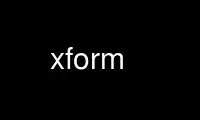
This is the command xform that can be run in the OnWorks free hosting provider using one of our multiple free online workstations such as Ubuntu Online, Fedora Online, Windows online emulator or MAC OS online emulator
PROGRAM:
NAME
xform - transform a RADIANCE scene description
SYNOPSIS
xform [ -c ][ -I ][ -n name ][ -m newmod ][ -f argfile ][ xf0 ][ -a n1 xf1 .. ][ -i 1 xff
] file ..
DESCRIPTION
Xform transforms each scene description file according to the options given. If no file
is specified, the standard input is read. The -c option causes commands in the input not
to be expanded. The default is to execute all in line commands. (See note below about
file names.) The -n option causes all identifiers to be prefixed with name. The -m
option causes all surfaces to be given the modifier newmod. The -I option causes all
surfaces to be inverted, reversing their surface normal orientations. These options are
followed by the transformation options, which are described below.
The -f option causes the xform command line to be constructed from the given file, by
inserting each line of the file at the current point in the command argument list. Each
line in the file will result in a logically separate invocation of xform, and may may
contain any valid xform arguments, including nested -f options. This is a convenient way
to specify multiple copies of an object that do not fit a regular array pattern, without
having to actually execute xform many times. Separate scene files may be specified this
way as well, but remember that the constructed command line must fit the format of initial
options (-n, -m, -c, -I) followed by the transform then the scene files. No initial
options may appear after the first transform option, and no transform options will be
understood after the first named file. In the special case where the argument to the -f
option is a hyphen ('-'), xform will take its arguments from the standard input. Note
that xform cannot simultaneously take its scene information from the standard input if the
option is used in this way. Competely empty lines and lines beginning with a pound sign
('#') will be silently ignored. Beginning "!xform" or "xform" command names will also be
ignored.
If one or more scene files are given on the command line, xform will search the RADIANCE
library directories for each file. (No search takes place if a file name begins with a
'.', '/' or '~' character.) Unless the -c option is present, xform will also change to
that file's directory before loading it. Thus, any commands executed within that file
will happen in that file's directory, which simplifies object hierarchy construction.
The transformation consists of a sequence of operations which are executed in the order
they appear.
OPTIONS
-t x y z Translate the scene along the vector x y z .
-rx degrees
Rotate the scene degrees about the x axis. A positive rotation corresponds to
counter-clockwise when looking down the axis.
-ry degrees
Rotate the scene degrees about the y axis.
-rz degrees
Rotate the scene degrees about the z axis.
-s factor Scale the scene by factor.
-mx Mirror the scene about the yz plane.
-my Mirror the scene about the xz plane.
-mz Mirror the scene about the xy plane.
-i count Iterate (repeat) the following transformation (up to the next -i option) count
times. This option is primarily to support the -a option, which is described
below.
Arrays
An array is a repeated transformation that results in a repeated object. It is specified
using the -a option, which takes the number to repeat as its argument. The objects will
step by the transformation given between this -a option and the next -a or -i option. The
first object will have zero applications of the transform. A two-dimensional array is
given by two different transformations each preceded by an array count.
EXAMPLE
To rotate ``book'' 30 degrees about the x axis then move 20 in y, prepending the name
book1:
xform -n book1 -rx 30 -t 0 20 0 book > book1
To expand all commands and see what information is actually used by RADIANCE:
xform scene | more
To create a two-dimensional array of 20 lights, after an initial rotation and followed by
a global translation (no command expansion):
xform -c -rz 90 -a 5 -t 2 0 0 -a 4 -t 0 1.5 0 -i 1 -t 0 0 10 light
ENVIRONMENT
RAYPATH path to search for scene files
Use xform online using onworks.net services
